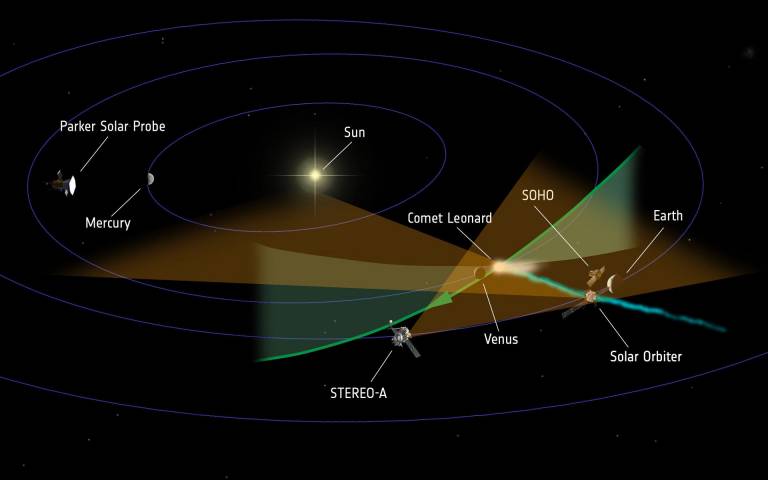For the second time in its mission so far, the Sun-observing spacecraft Solar Orbiter has flown through the tail of a comet, generating a wealth of science data - helped by an early prediction of the event by a UCL PhD researcher.

For several days in mid-December, the European Space Agency (ESA) spacecraft - which carries instruments designed and built at UCL - found itself flying through the ion tail of Comet C/2021 A1 Leonard, analysing particles from the comet and the way its tail interacted with the solar wind.
The crossing had been predicted by Samuel Grant, a research student at the Mullard Space Science Laboratory at UCL. He adapted an existing computer program, developed by Professor Geraint Jones (UCL Mullard Space Science Laboratory), that compared spacecraft orbits with comet orbits to include the effects of the solar wind and its ability to shape a comet's tail. (Both researchers are also affiliated with the Centre for Planetary Sciences at UCL/Birkbeck.)
Grant said: "I ran it with Comet Leonard and Solar Orbiter with a few guesses for the speed of the solar wind. And that's when I saw that even for quite a wide range of solar wind speeds it seemed like there would be a crossing."
Comet Leonard was first spotted in the outer solar system in January last year. Speeding close by Earth, Venus and the sun over December and January, it has now hurtled away from the solar system into interstellar space.
At the time of the crossing, Solar Orbiter was relatively close to Earth, in a gravity assisted maneouvre ahead of its return to the Sun. The comet's nucleus was 44.5 million kilometres away, near to the planet Venus, but its giant ion tail stretched across space to Earth's orbit and beyond.
So far, the best detection of the comet's tail from Solar Orbiter has come from the Solar Wind Analyser (SWA) instrument suite, led by UCL scientists. Its Heavy Ion Sensor (HIS) clearly measured ions that are attributable to the comet rather than the solar wind.
Ions are atoms or molecules that have been stripped of one or more electron and now carry a net positive electrical charge. SWA-HIS detected ions of oxygen, carbon, molecular nitrogen, and molecules of carbon monoxide, carbon dioxide and possibly water.
Professor Christopher Owen (UCL Mullard Space Science Laboratory), Principal Investigator of SWA, said: "It is very satisfying to see predictions coming out of UCL being validated by the high-quality observations being made by SWA, which in turn are the result of many years of hard work by UCL/MSSL scientists and engineers in conceiving, designing, building and now operating the instrument."






